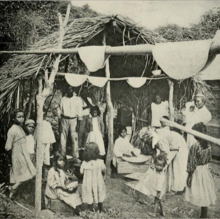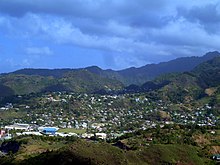Saint Vincent and the Grenadines
It is located in the southeast Windward Islands of the Lesser Antilles, which lie in the West Indies, at the southern end of the eastern border between the Caribbean Sea and the Atlantic Ocean.Spanning a land area of 369 km2 (142 sq mi), most of its territory consists of the northernmost island of Saint Vincent, which includes the capital and largest city, Kingstown.To the south lie two-thirds of the northern part of the Grenadines, a chain of 32 smaller islands; the remaining southern third make up Grenada.In April 2021, the La Soufrière volcano erupted several times with "explosive events" continuing for two weeks, resulting in the evacuation of 16,000 residents.[15][16] Before the arrival of Europeans and Africans in the 16th century, various Amerindian groups passed through or settled on St. Vincent and the Grenadines, including the Ciboney, Arawak, and Kalinago people.[19] The French imported Black slaves to work on plantations producing sugar, coffee, indigo, tobacco, cotton and cocoa.[20] The British captured the island and drove out the French from Barrouallie during the Seven Years' War, a claim confirmed by the Treaty of Paris (1763).[19] The Garifuna were led by paramount chief Joseph Chatoyer and supported by the French, notably Victor Hugues who was based on the island of Martinique.They were eventually defeated in 1797 by British forces under the command Sir Ralph Abercromby; a peace treaty agreement was made which resulted in almost 5,000 Garifuna being deported to Roatán, an island off the coast of Honduras, and to Belize and Baliceaux in the Grenadines.A representative assembly was authorised in 1776, Crown Colony government was installed in 1877, a legislative council was created in 1925 with a limited franchise,[19] and universal adult suffrage was granted in 1951.[19] This gave Saint Vincent complete control over its internal affairs but fell short of full independence in law.[15] The country opted to remain within the Commonwealth of Nations, retaining the then-Queen Elizabeth II as Monarch, represented locally by a Governor-General.In November 2020, Ralph Gonsalves, Prime Minister of Saint Vincent and the Grenadines since 2001, made history by securing the fifth consecutive victory of his Unity Labour Party (ULP) in general election.[15] He does not reside in the islands and is represented as head of state in the country by the Governor-General of Saint Vincent and the Grenadines, currently Susan Dougan (since 1 August 2019).[41] The office of Governor-General has mostly ceremonial functions including the opening of the islands' House of Assembly and the appointment of various government officials.[48] The island nation's sixth embassy overseas was opened on 8 August 2019 in Taipei, Taiwan, after Prime Minister Ralph Gonsalves's official visit to the Republic of China (Taiwan);[49] the other five are located in London (a High Commission as Commonwealth countries have high commissions rather than embassies in each other's countries), Washington D.C., Havana, Caracas and Brussels.[50] On 6 July 1994 at Sherbourne Conference Centre, St Michael, Barbados, as a representative of the Government of St. Vincent and the Grenadines, then (James Mitchell, who was subsequently knighted) signed the Double Taxation Relief (CARICOM) Treaties.[48] On 30 June 2014, St. Vincent and the Grenadines signed a Model 1 agreement with the United States of America with respect to Foreign Account Tax Compliance (Act) or FATCA.In September 2017, at the 72nd Session of the UN General Assembly, the Prime Ministers of the Solomon Islands, Tuvalu, Vanuatu and Saint Vincent and the Grenadines called for UN action on alleged human rights abuses committed by Indonesia on Western New Guinea's indigenous Papuans.[57] Upon a visit in April 2022, the British Duke and Duchess of Edinburgh were confronted with protesters calling for reparations for Britain's participation in the slave trade.[58][59] Saint Vincent protests against Venezuela's claim to give full effect to Aves (Bird) Island, which creates a Venezuelan EEZ/continental shelf extending over a large portion of the Caribbean Sea.[61] The continuing dependence on a single crop represents the biggest obstacle to the islands' development as tropical storms wiped out substantial portions of bananas in many years.There are other ethnic groups, such as Portuguese (from Madeira) and East Indians, both brought in to work on the plantations after the abolishing of slavery by the British living on the island.[72] English is used in education, government, religion, and other formal domains, while Creole (or 'dialect' as it is referred to locally) is used in informal situations, such as in the home and among friends.A notable Vincentian footballer is Ezra Hendrickson, former national team captain who played at several Major League Soccer clubs in the United States and was head coach with the Chicago Fire FC from 2021–23.Music popular in Saint Vincent and the Grenadines includes big drum, calypso, soca, steelpan and reggae.







Saint Vincent (Antilles)GrenadinesSaint Vincent (disambiguation)Grenadine (disambiguation) Coat of armsSaint Vincent, Land so BeautifulRoyal anthemGod Save the KingKingstownEnglishVernacular languageVincentian CreoleEthnic groupsBlack (African)IndianEuropeanKalinagoChristianityProtestantismChristianHinduismno religionRastafariBaháʼí FaithDemonym(s)Vincentian and GrenadinianGovernmentparliamentary constitutional monarchyMonarchCharles IIIGovernor-GeneralSusan DouganPrime MinisterRalph GonsalvesHouse of AssemblyIndependenceAssociated StateUnited KingdomPopulationEast Caribbean dollarDrives onCalling code+1 784ISO 3166 codeInternet TLDisland countryCaribbeanWindward IslandsLesser AntillesWest IndiesCaribbean SeaAtlantic OceanSaint LuciaBarbadosGrenadaSaint VincentCarriacouBequiaMustiqueCanouanUnion IslandCommonwealth of NationsOrganisation of Eastern Caribbean StatesCARICOMBolivarian Alliance for the AmericasCommunity of Latin American and Caribbean StatesLa SoufrièreeruptedUnited NationsWorld BankChristopher ColumbusSt. Vincent of Saragossafeast dayGranadathe island of the same nameHistory of Saint Vincent and the GrenadinesFrench West IndiesBritish West IndiesAmerindianCiboneyArawakIsland CaribsBarrouallieleewardGarifunaSeven Years' WarTreaty of Paris (1763)Fort CharlotteFirst Carib WarAnglo-French War (1778–1783)recaptured St VincentTreaty of Versailles (1783)British Windward IslandsSecond Carib WarJoseph ChatoyerVictor HuguesMartiniqueRalph AbercrombyRoatánHondurasBelizeBaliceauxabolishedPortuguese CatholicMadeiraPortugalIndian labourersWest Indies Federationcasabelegislative counciluniversal adult suffrageIndependence Daypublic holidayElizabeth IIMilton CatoSaint Vincent Labour Party1984 Vincentian general electionJames Fitz-Allen MitchellNew Democratic PartyelectionsHurricane LennyArnhim EustacedefeatedUnity Labour Partyreparationsa referendum was held on a proposal to adopt a new constitution